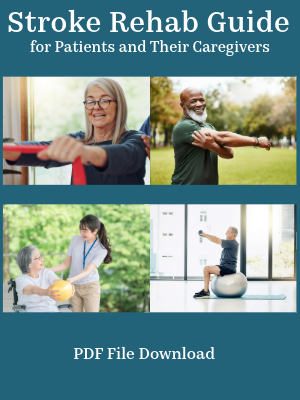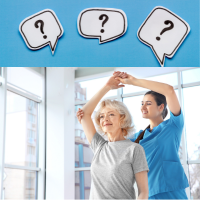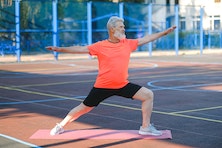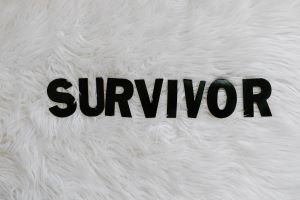Stroke Rehab Exercises
Medically reviewed by Karen Murray, OT, CHT, CSRS - written by Stroke-rehab.com
The number of stroke rehab exercises can be overwhelming especially after being in the acute hospital, inpatient rehab, and outpatient therapy then coming home with multiple home exercise programs. To better understand the types of stroke rehab exercises prescribed for home and their benefits, see below. The underlined links lead to pages with more information on the topic.
Passive Range of Motion Exercises
Passive range of motion refers to an external force moving a body part rather than it moving on its own volition. Examples would be a patient taking his strong arm and moving the weak or paralyzed arm, a caregiver or therapist moving an affected limb, or a machine moving an extremity. Passive range of motion exercises are important to maintain flexible joints and prevent joint contracture.
Joint contracture occurs when there are structural changes to the soft tissue such as tightening or shortening of muscles and tendons that restrict movement. It is important to perform passive range of motion even if you have experienced total paralysis because a contracture can predispose one to skin breakdown, tissue irritation, pain, decreased blood flow, and prevent one from moving a limb if muscle function does return. Joint contractures also interfere with activities of daily living such as trying to wash under one’s arm, donning clothing over a contracted elbow or knee, or cleaning the fingernails of a contracted hand.
Visit our PROM webpage to see pictures of how to do self passive range of motion for yourself.
The video below shows how each joint is moved through passive range of motion by a helper. The subject in the video does not have a stroke and has full range of motion. When performing passive range of motion on a stroke patient with limited range of motion, the exercises would only be done in a pain-free range, performed more slowly, and the helper should be aware of the patient's available movement or range of motion. Never force movement if you feel resistance or the patient expresses pain. A licensed occupational or physical therapist can teach caregivers how to do passive range of motion on a stroke patient.
Active Assistive Range of Motion
Active assistive range of motion occurs when a weak limb is assisted through movement. The weak limb is helping but cannot perform all of the work on its own. An example would be someone that could only partially lift their arm and a therapist assists them in lifting the arm further (or they use their strong arm as an assist). Active assistive range of motion is helpful in strengthening a limb that does not yet have full range of motion. The following video is an example of active assistive range of motion.
Active Range of Motion Exercises
|
Active Range of Motion (AROM) occurs when a person can move a body part on their own without assistance. Many stroke patients with movement on the weak side may not be strong enough to add resistance exercises and may perform active range of exercises. AROM helps promote joint flexibility, strengthening, and increased muscular endurance. See examples of leg active range of motion exercises. |
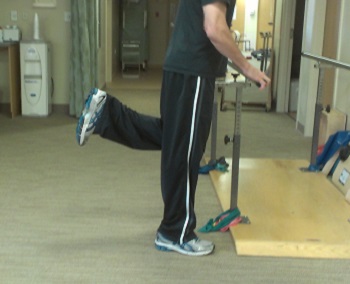 |
Strengthening or Resistance Training
Stroke rehab exercises often consists of strengthening activities that involve moving a body part against resistance. This type of exercise will gradually and progressively overload the muscles so that they will get stronger.
There are many types of strengthening exercise equipment including bands, dumbbells, tubing, putty, and exercise machines. See examples of arm strengthening exercises.
As an Amazon Associate I earn from qualifying purchases.
Stretching
Muscles often become tight or have tone after a stroke. Stretching or performing flexibility exercises on a regular basis can help prevent joint contracture and muscle shortening. Sometimes manual stretching is not enough and a patient may need a splint to help stretch tight joint and muscles.
Flexibility can often be improved through classes such as Yoga, Pilates, and Tai Chi, but it is important for a stroke patient to find an instructor that is experienced in working with clients who have disability/mobility issues as exercises will most likely have to be adapted for safety.
Weight Bearing Exercises
|
Weight Bearing Exercises are often unfamiliar to patients but can be some of the most important exercises that one does. Weight bearing can help improve balance, reduce excessive tone brought on by a stroke and strengthen weak muscles. |
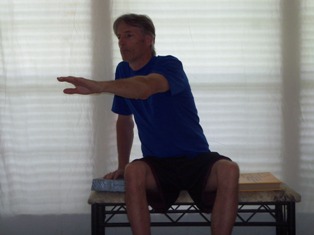 |
One of the most important reasons to do weight bearing is to help prevent bone loss. If a stroke victim tends to put all of their weight on the strong leg, then the weak leg will begin to experience decreases in bone density. This bone loss can lead to “brittle bones” which also puts a person at higher risk for fractures. It is important to do weight bearing for the arms and legs.
Scapula Mobilization
The muscles that attach to the scapula (or shoulder blade) are often affected after a stroke. These muscles may become weak or have increased tone. If the scapula cannot move properly, one cannot lift their arm overhead. If the scapula is unstable, then arm movement may be jerky or uncontrolled. Scapular mobilization exercises help move or mobilize the scapula in order to maintain or improve shoulder range of motion and prevent pain.
Balance Training
Stroke victims often have poor balance. If balance is affected, one of the first things a patient must learn in stroke rehab is the ability to maintain their balance in sitting. Sitting balance exercises focus on strengthening the core or trunk musculature. Standing balance exercises will help improve a patient’s ability to stand in place as well as walk or perform activities without loss of balance. Balance exercises are extremely important in helping prevent falls.
Gross and Fine Motor Skills
Coordination exercises for gross motor skills emphasize fine tuning large muscle movements such as walking, throwing, and moving the limbs in a coordinated manner.
Fine motor skills involve hand dexterity which is important for picking up objects, feeding oneself, buttoning clothes, writing and many other activities. Fine motor exercises help a patient improve use of the hand for manipulating small objects.
As an Amazon Associate I earn from qualifying purchases.
Constraint Induced Movement Therapy
Constraint Induced Movement Therapy (CI Therapy or CIMT) sometimes referred to as forced use therapy by some is a stroke rehab technique which involves limiting the movement of the strong side or non-affected side and “forcing” the weaker or affected side to attempt activities. This technique was developed by Edward Taub and his research team at the University of Alabama at Birmingham (UAB) and usually consists of using a sling or mitt for 90% of waking hours on the non-affected arm, while intensively trying to use the more-affected arm.
Modified CIMT (mCIMT) has also been developed by Stephen Page and colleagues as a less intense but more practical treatment that involves the same principles as CIMT but with less time than traditional CIMT.
Eye ExercisesStroke survivors may suffer visual problems such as visual field loss, visual spatial disorders, impaired eye movement or double vision. Eye exercises can help with these visual deficits. Vision therapy is often overlooked in stroke rehab. If you have visual impairment following a stroke, ask your occupational therapist or an optometrist about eye exercises. Participants in a 2009 study actually regained some of their visual field loss after doing eye exercises for an extended period of time. |
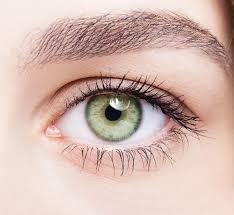 |
Improving Sensation or Sensory Re-education
Following stroke, one may have decreased sensation, numbness, or tingling. This can be especially difficult if sensation is impaired in the hands. Forms of sensation that can be impaired are detection of heat/cold, pain, light and deep touch. Stroke patients may also be unable to discriminate where they are being touched (i.e. touch on the elbow feels as if it occurred on the upper arm). Decreased sensation can greatly impair the use of hands causing one to drop objects, have difficulty with fine motor tasks, and be at risk for burning oneself. Sensory re-education exercises involve retraining the sensory system in the attempt to improve sensation and hand function.
Swallowing Exercises
Dysphagia or trouble with swallowing can be a very serious impairment even life threatening. If food or drink enters into the lungs rather than the stomach, this is called aspiration and can lead to aspiration pneumonia. A licensed speech pathologist or speech therapist can help a patient with dysphagia through swallowing exercises and diet modifications. The speech therapist will recommend the appropriate diet to prevent aspiration. This may include thickened liquids, pureed food, or even nutrition through a feeding tube if a patient’s swallowing is severely impaired. One may not even be aware that they are aspirating food or drink, so it is important to have a swallow study after a stroke and participate in any exercises or recommendations made by the speech therapist.
Brain Exercises (Cognitive Exercises) |
 |
Exercises to improve cognition may be directed at memory, problem solving, reasoning, following directions, initiation of activity, and comprehension. A speech therapist will often work with a patient on these exercises, but an occupational therapist may also work on cognitive activities with a patient to help with daily tasks such as paying bills, cooking, and work activities. There are many cell phone apps and online websites that offer brain training, but these online exercises may not necessarily carry over into improvement in everyday functioning, so it is best to also include real life cognitive practice rather than only doing computer activities.
Speech Exercises |
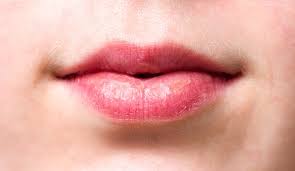 |
Speech exercises may focus on dysarthria (difficulty speaking because of weak muscles) and/or aphasia which is difficulty with expressive and receptive communication that impairs speech. Stroke patients with dysarthria, expressive aphasia, and receptive aphasia will all need speech therapy. Dysarthia exercises will focus on improving weak mouth and tongue musculature. Aphasia exercises will focus on various techniques to improve language comprehension and expression, such as word-finding exercises, repetition drills, and conversational practice. Aphasiatherapyonline.com is a website that provides free exercises for aphasia.
Other Stroke Rehab Exercises
As an Amazon Associate I earn from qualifying purchases.
Other stroke rehab exercises include the use of technology such as brain computer interfaces and robotics, mirror box therapy, graded imagery, and more. There are many devices on the market today to help with stroke recovery as well as various types of stroke rehab exercises being developed on a continuous basis. It is important to keep up with current research to find out which stroke rehab exercises are effective. www.EBRSR.com is a website that offers information on the latest stroke research and the effectiveness of various rehabilitation techniques.
Help for Home Exercises
For examples of inexpensive exercise equipment you can use for rehab at home, visit www.stroke-rehab.com/home-exercise-equipment.html. You can also subscribe to our stroke blog page to get the our latest website updates regarding exercises, treatment, and answers to questions from stroke patients.
Do You Have a Stroke Treatment Recommendation?
Have you had a good experience with your stroke rehabilitation and treatment? Or maybe you're a therapist who treats stroke with some recommendations. Please share your favorite and most effective stroke rehab exercises or treatment tips below. Please note that submissions from others are for informational purposes only and are not professional medical advice, diagnosis, treatment or care, nor are intended to be a substitute. Always seek the advice of a physician or other qualified health provider concerning questions you have regarding your health or a loved one's health concerns.
Get Our Stroke Rehab Guide

Our stroke rehab guide is designed specifically for patients and caregivers. It's in pdf format and can be immediately downloaded. It includes about
- Stroke Definition & Causes
- Stroke Treatment
- Rehabilitation Information for Physical, Occupational and Speech Therapy
- Exercise pictures
- Q&A from patients and caregivers
- Adaptive Equipment & Techniques
- How to Prevent Another Stroke & More!
Medical Disclaimer: All information on this website is for informational purposes only. This website does not provide medical advice or treatment. Always seek the advice of your physician or other healthcare provider before undertaking a new healthcare or exercise regimen. Never disregard professional medical advice or delay seeking medical treatment because of something you have read on this website. See the disclaimer page for full information.
- Home
- Guide to Exercises
